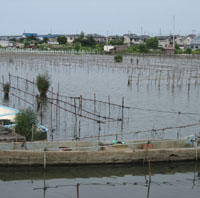WEARABLE RAINBOWS
 Few things in the world make a rainbow you can wear, and a select collection of Biwa Pearls is one of them. When Mr. Tamura spilled the first bag of Biwa Pearls out across the gray-silk covered table in the pearl-showing place of his house in Katata, a rainbow filled the room.
Few things in the world make a rainbow you can wear, and a select collection of Biwa Pearls is one of them. When Mr. Tamura spilled the first bag of Biwa Pearls out across the gray-silk covered table in the pearl-showing place of his house in Katata, a rainbow filled the room. I'd never heard of Biwa Pearls until a few years ago, when I saw in a Sundance catalog a string of small copper-colored baroque pearls that were described as "Biwa Pearls." I Googled the name to see if there was any connection to Lake Biwa (how many Biwas are there?) and found nearly 25,000 responses. I assumed then that it was an old and thriving industry here, and backburner-vowed to check it out one day.
Then when I was in the States, Liz, my beloved sister-in-law, who, though a college dean also makes jewelry, asked me if there was any way she could get hold of some Biwa Pearls, they were so hard to get in the States (quote from beadsbymail.com: "Never have we seen such a madhouse as at the pearl seller's tables when we were in Tucson. We were fortunate to be able to obtain the Biwa Pearls we show you here. Customers were scooping them up with both hands, not even looking at the individual strands! We've never seen such a pearl battle zone.") I had seen the Tamura Family Biwa Pearl sign on one of my favorite walks in Katata and promised Liz that when I got back to Japan I'd check, see what I could find out.
Thus it was that Echo and I were at the table when Mr Tamura created a rainbow, by appointment only. The Tamura family lives not far from the lakeside beds in which Mr. Tamura and his son create each of these unique beauties. A gracious man, he took the time to tell us the history of Biwa Pearls (it all began in the 1930s) and how in the heyday there were 70 or so families in the business, which he entered 45 years ago.

During the Tanaka era (1972-74), many Chinese came here on cultural exchange programs and were taught by Mr. Tamura and others how to create freshwater pearls. Since then, pollution (mainly from detergent influx, since outlawed) and heavily increasing competition from the Chinese (who with no shame market their product as "Biwa Pearls"!) have taken their toll on the local (but genuine) Biwa Pearl business. I'd thought that the Tamuras were one of maybe three or four families still growing Biwa Pearls in the eponymous Lake, but as he explained while laying out pearlescent strings and cascades of gold, copper, pink, blue, gray, black, round, oval and baroque pearls in a rainbow of colors before us: they are the last family in the business here...
He explained in detail how Biwa Pearls are grown and selected (individual top-pearl prices ranging from 50 to several hundred dollars) and if guys could wear pearls I would have bought one unique necklace worth... Here's hoping that Biwa pearls make the comeback they deserve. I'll talk to Cameron Diaz and Julia Roberts, see if they'll wear a strand or two, three or four in Cannes; or to the Oscars, maybe...
The younger Tamura has made a good start, in registering biwapearl.com...


















1 comment:
These are so beautiful- I bead, make other little creations...and these are so incredible....I would not even know where to find them here- amazing..and so sad that they are so rare..I will have to find some...a new quest...
last year I do remember seeing a woman in California with them on a necklace- I did not know they were rare at the time( thought it was a california thing...)thanks for posting this....
Post a Comment